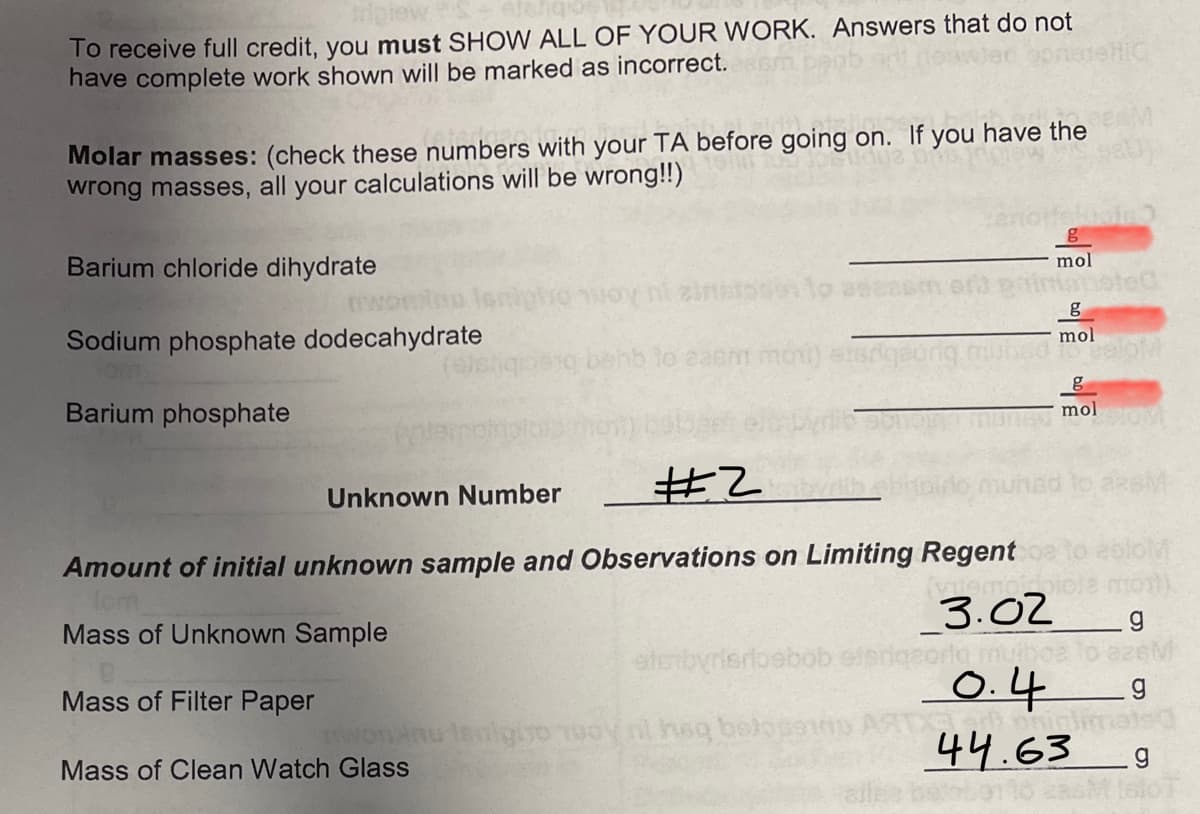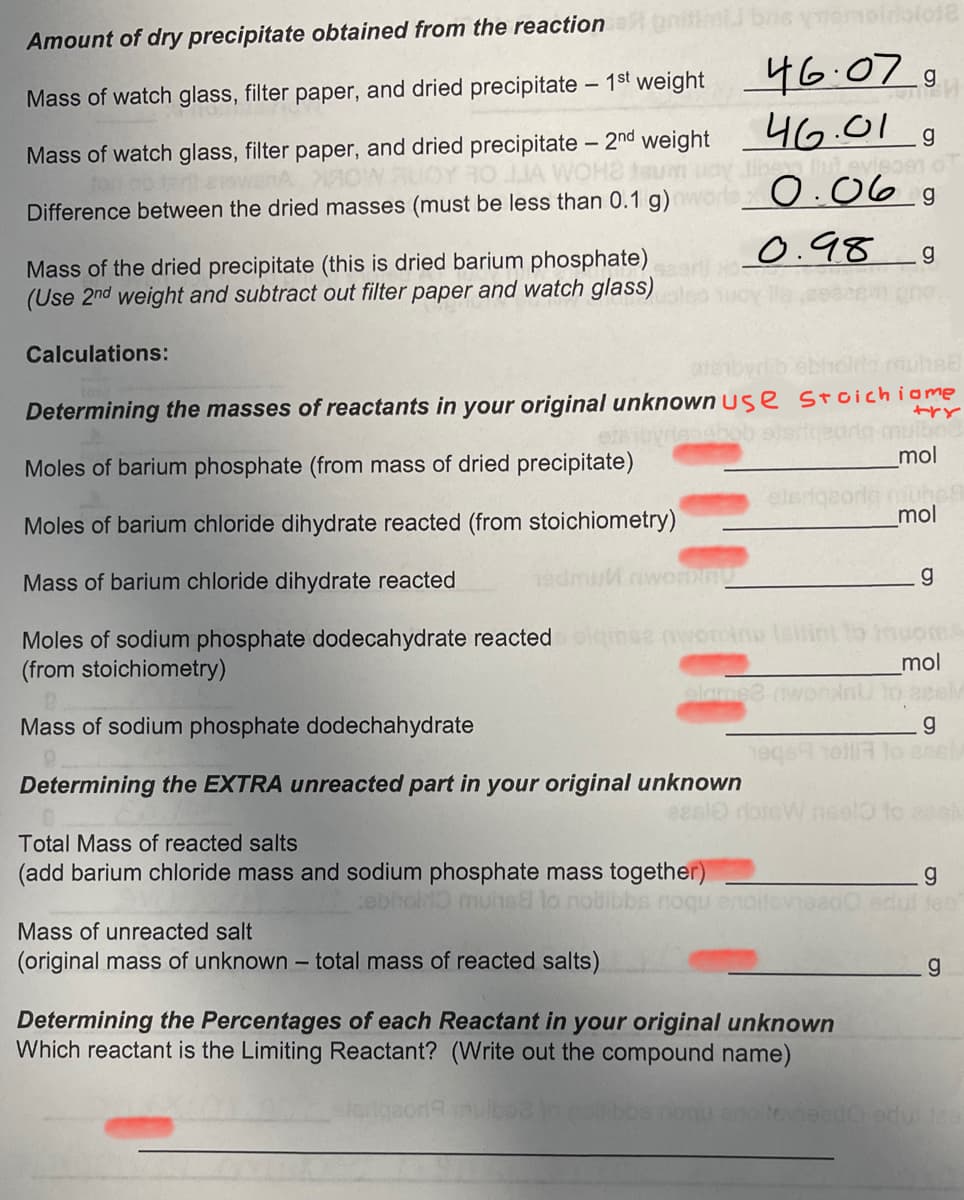Chemistry: The Molecular Science
5th Edition
ISBN:9781285199047
Author:John W. Moore, Conrad L. Stanitski
Publisher:John W. Moore, Conrad L. Stanitski
Chapter2: Chemical Compounds
Section: Chapter Questions
Problem 2.CCP
Related questions
Question
I need help on the ones with a red line next to it

Transcribed Image Text:To receive full credit, you must SHOW ALL OF YOUR WORK. Answers that do not
have complete work shown will be marked as incorrect.
HIC
Molar masses: (check these numbers with your TA before going on. If you have the
wrong masses, all your calculations will be wrong!!)
Barium chloride dihydrate
mol
ni zinstsse
Intansted
Sodium phosphate dodecahydrate
mol
lo easm mo)
Barium phosphate
mol
#乙
Unknown Number
eololM
emtoiote mo).
3.02
Amount of initial unknown sample and Observations on Limiting Regent
Mass of Unknown Sample
eterbyrisrloebob elen
Mass of Filter Paper
0.4
wwonnu lanlgivo Tuoy nl haq balosano
44.63
elle
Mass of Clean Watch Glass

Transcribed Image Text:Amount of dry precipitate obtained from the reaction
46.07 g
46.01
Mass of watch glass, filter paper, and dried precipitate - 1st weight
g
Mass of watch glass, filter paper, and dried precipitate - 2nd weight
viegen o
0.06 g
Difference between the dried masses (must be less than 0.1 g)
0.98
Mass of the dried precipitate (this is dried barium phosphate).
(Use 2nd weight and subtract out filter paper and watch glass)
g
Calculations:
ebholda muhsE
Determining the masses of reactants in your original unknown use stoichio me
Mibo
Moles of barium phosphate (from mass of dri
precipitate)
mol
Moles of barium chloride dihydrate reacted (from stoichiometry)
mol
Mass of barium chloride dihydrate reacted
g
Moles of sodium phosphate dodecahydrate reacted m02 nwoinu tst
(from stoichiometry)
mol
Mass of sodium phosphate dodechahydrate
lo seel
Determining the EXTRA unreacted part in your original unknown
eeslo doteW neelo
Total Mass of reacted salts
(add barium chloride mass and sodium phosphate mass together)
Omute
noqu enoiteveadO edul tee
Mass of unreacted salt
(original mass of unknown - total mass of reacted salts)
Determining the Percentages of each Reactant in your original unknown
Which reactant is the Limiting Reactant? (Write out the compound name)
odu le
Expert Solution
This question has been solved!
Explore an expertly crafted, step-by-step solution for a thorough understanding of key concepts.
This is a popular solution!
Trending now
This is a popular solution!
Step by step
Solved in 3 steps

Knowledge Booster
Learn more about
Need a deep-dive on the concept behind this application? Look no further. Learn more about this topic, chemistry and related others by exploring similar questions and additional content below.Recommended textbooks for you

Chemistry: The Molecular Science
Chemistry
ISBN:
9781285199047
Author:
John W. Moore, Conrad L. Stanitski
Publisher:
Cengage Learning

Introductory Chemistry: A Foundation
Chemistry
ISBN:
9781337399425
Author:
Steven S. Zumdahl, Donald J. DeCoste
Publisher:
Cengage Learning

Chemistry
Chemistry
ISBN:
9781305957404
Author:
Steven S. Zumdahl, Susan A. Zumdahl, Donald J. DeCoste
Publisher:
Cengage Learning

Chemistry: The Molecular Science
Chemistry
ISBN:
9781285199047
Author:
John W. Moore, Conrad L. Stanitski
Publisher:
Cengage Learning

Introductory Chemistry: A Foundation
Chemistry
ISBN:
9781337399425
Author:
Steven S. Zumdahl, Donald J. DeCoste
Publisher:
Cengage Learning

Chemistry
Chemistry
ISBN:
9781305957404
Author:
Steven S. Zumdahl, Susan A. Zumdahl, Donald J. DeCoste
Publisher:
Cengage Learning

Chemistry: An Atoms First Approach
Chemistry
ISBN:
9781305079243
Author:
Steven S. Zumdahl, Susan A. Zumdahl
Publisher:
Cengage Learning


Chemistry & Chemical Reactivity
Chemistry
ISBN:
9781337399074
Author:
John C. Kotz, Paul M. Treichel, John Townsend, David Treichel
Publisher:
Cengage Learning